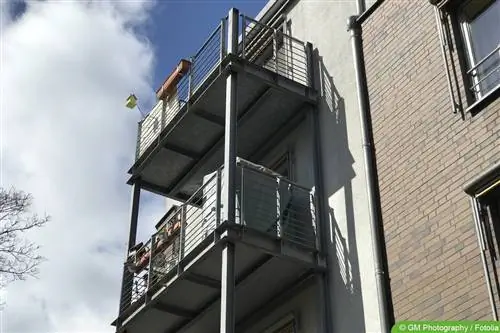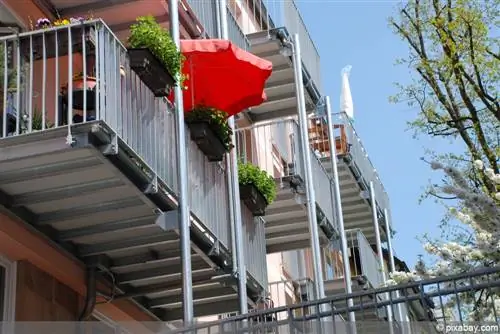- Author admin [email protected].
- Public 2023-12-17 03:39.
- Last modified 2025-01-24 12:45.
Balconies on the house can be used in different ways. The load-bearing capacity of the structure sets natural limits. In the following article you will find out what load is possible.
Static specifications
No matter what material or type of construction it is - all balconies must be able to withstand between 400-500 kilograms per square meter. This is regulated inDIN EN 1991-1-1:2010-12 in conjunction with DIN EN 1991-1-1/NA:2010-12 (has replaced DIN 1055-3)..
Different material
The material depends on the concrete load capacity of a balcony. Reinforced concrete or metal are considered the materials that best withstand loads. Wood, on the other hand, is less suitable. After all, this is more vulnerable to the weather.
Note:
If you choose a wooden structure, the material must be replaced regularly.
Maximum load limit
Every balcony has a limited load capacity. Construction and material determine the maximum load limit. Basically, you should always keep an eye on the maximum load in order to prevent damage. In the worst case, the structure can collapse if you ignore the load limit.

Guide values per square meter
The static specifications differ depending on the year the building was built. The guide values are in the relevantDIN EN 1991-1-1:2010-12 in conjunction with DIN EN 1991-1-1/NA:2010-12 (has replaced DIN 1055-3). Balconies must withstand at least the following weight:
- Buildings built up to 2010: 500 kilograms per square meter
- Building with year of constructionfrom 2010: 400 kilograms per square meter
Tip:
Balconies were previously often used as a storage place for heavy loads (including wood and coal for heating), but this task is now almost completely eliminated.
Load limit decreases
Compliance with the guidelines is necessary for the construction of the balcony. However, this does not mean that the design will safely meet all requirements in the future. Over the years, the maximum possible load decreases. Weather influences affect the material and ensure a decreasing load capacity.
Note:
If you have concerns about the current load-bearing capacity of the balcony, you should consult a structural engineer.
Everyday use
If you use it every day, you can enter the balcony without hesitation. After all, balcony furniture, flower pots and an appropriate number of people rarely reach the permitted load. This type of everyday use is not a problem for the balcony construction. This only looks different when homeowners use their balconies exceptionally.
Note:
Up to four people per square meter do not reach the limit of exposure. This already shows that in most cases the maximum load capacity is not achieved.
Extraordinary use
However, under certain circumstances, using the balcony may cause problems. This is the case, for example, with heavy constructions:
- Paddling pool
- Sandbox
- Raised bed
- Hot tub
Note:
The weight of water is often underestimated. A water height of just 40 centimeters means a weight of 400 kilograms per square meter. Together with the weight of the paddling pool or whirlpool users, the maximum load capacity has been exceeded.
Regular inspection
Regular inspection is recommended in order to detect damage to the balcony at an early stage. Naturally, larger damages are noticed more quickly. At the same time, you should also keep an eye on small cracks and damage. The first signs of danger vary depending on the material:
- Reinforced concrete: small cracks
- Metal: Rust
- Wood: Rot or pest infestation
Tip:
With good care you can prevent the first damage. For example, you can use a sealant for the wood or red preventative for metal structures.
Liability for load capacity
Basically, the owner of a property is liable for the load capacity of the balconies. However, the tenant has a duty to cooperate since they see the balcony more often. If the tenant notices any changes, he must inform the owner. In addition, the architects and structural engineers may also be liable. Although there is no express legal regulation, tenants should pay attention to the rental agreement. In some cases, the landlords contractually regulate which use of the balcony is permitted in order to avoid static hazards.
Note:
If a balcony falls, legal advice is required. Ultimately, the owner, structural engineer, architect, construction company or supplier may be liable.






